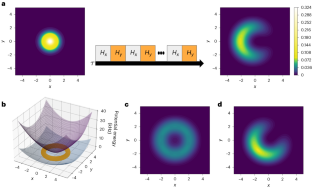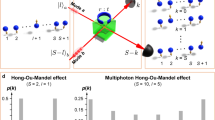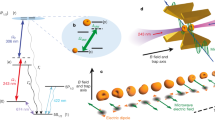Abstract
Conical intersections often control the reaction products of photochemical processes and occur when two electronic potential energy surfaces intersect. Theory predicts that the conical intersection will result in a geometric phase for a wavepacket on the ground potential energy surface, and although conical intersections have been observed experimentally, the geometric phase has not been directly observed in a molecular system. Here we use a trapped atomic ion system to perform a quantum simulation of a conical intersection. The ion’s internal state serves as the electronic state, and the motion of the atomic nuclei is encoded into the motion of the ions. The simulated electronic potential is constructed by applying state-dependent optical forces to the ion. We experimentally observe a clear manifestation of the geometric phase using adiabatic state preparation followed by motional state measurement. Our experiment shows the advantage of combining spin and motion degrees for quantum simulation of chemical reactions.

This is a preview of subscription content, access via your institution
Access options
Access Nature and 54 other Nature Portfolio journals
Get Nature+, our best-value online-access subscription
$29.99 / 30 days
cancel any time
Subscribe to this journal
Receive 12 print issues and online access
$259.00 per year
only $21.58 per issue
Buy this article
- Purchase on Springer Link
- Instant access to full article PDF
Prices may be subject to local taxes which are calculated during checkout



Similar content being viewed by others
Data availability
Source data are provided with this paper.
References
McArdle, S., Endo, S., Aspuru-Guzik, A., Benjamin, S. C. & Yuan, X. Quantum computational chemistry. Rev. Mod. Phys. 92, 015003 (2020).
Kassal, I., Jordan, S. P., Love, P. J., Mohseni, M. & Aspuru-Guzik, A. Polynomial-time quantum algorithm for the simulation of chemical dynamics. Proc. Natl Acad. Sci. USA 105, 18681–18686 (2008).
Larson, J., Sjöqvist, E. & Öhberg, P. Conical Intersections in Physics (Springer, 2020).
Yarkony, D. R. Diabolical conical intersections. Rev. Mod. Phys. 68, 985 (1996).
Berry, M. V. Quantal phase factors accompanying adiabatic changes. Proc. R. Soc. Lond. A. 392, 45–57 (1984).
Cina, J. A., Smith Jr, T. J. & Romero-Rochín, V. Time-resolved optical tests for electronic geometric phase development. Adv. Chem. Phys. 83, 1–42 (1992).
Cina, J. A. Phase-controlled optical pulses and the adiabatic electronic sign change. Phys. Rev. Lett. 66, 1146 (1991).
Farag, M. H., Jansen, T. L. & Knoester, J. Probing the interstate coupling near a conical intersection by optical spectroscopy. J. Phys. Chem. Lett. 7, 3328–3334 (2016).
Köppel, H. Ultrafast non-radiative decay via conical intersections of molecular potential-energy surfaces: C2H4+. Chem. Phys. 77, 359–375 (1983).
Chen, L., Gelin, M. F., Zhao, Y. & Domcke, W. Mapping of wave packet dynamics at conical intersections by time-and frequency-resolved fluorescence spectroscopy: a computational study. J. Phys. Chem. Lett. 10, 5873–5880 (2019).
Blatt, R. & Roos, C. F. Quantum simulations with trapped ions. Nat. Phys. 8, 277–284 (2012).
Lloyd, S. Universal quantum simulators. Science 273, 1073–1078 (1996).
MacDonell, R. J. et al. Analog quantum simulation of chemical dynamics. Chem. Sci. 12, 9794–9805 (2021).
Gambetta, F. M., Zhang, C., Hennrich, M., Lesanovsky, I. & Li, W. Exploring the many-body dynamics near a conical intersection with trapped rydberg ions. Phys. Rev. Lett. 126, 233404 (2021).
Wüster, S., Eisfeld, A. & Rost, J. Conical intersections in an ultracold gas. Phys. Rev. Lett. 106, 153002 (2011).
Wüster, S. & Rost, J. M. Rydberg aggregates. J. Phys. B. 51, 032001 (2018).
MacDonell, R. J. et al. Predicting molecular vibronic spectra using time-domain analog quantum simulation. Preprint at arXiv https://doi.org/10.48550/arXiv.2209.06558 (2022).
Omiya, K. et al. Analytical energy gradient for state-averaged orbital-optimized variational quantum eigensolvers and its application to a photochemical reaction. J. Chem. Theory Comput. 18, 741–748 (2022).
Tamiya, S., Koh, S. & Nakagawa, Y. O. Calculating nonadiabatic couplings and berry’s phase by variational quantum eigensolvers. Phys. Rev. Res. 3, 023244 (2021).
Wang, C. S. et al. Observation of wave-packet branching through an engineered conical intersection. Phys. Rev. X 13, 011008 (2023).
Brown, C. D. et al. Direct geometric probe of singularities in band structure. Science 377, 1319–1322 (2022).
Nam, Y. et al. Ground-state energy estimation of the water molecule on a trapped-ion quantum computer. npj Quantum Inf. 6, 1–6 (2020).
Hempel, C. et al. Quantum chemistry calculations on a trapped-ion quantum simulator. Phys. Rev. X 8, 031022 (2018).
Porras, D., Ivanov, P. A. & Schmidt-Kaler, F. Quantum simulation of the cooperative Jahn–Teller transition in 1D ion crystals. Phys. Rev. Lett. 108, 235701 (2012).
Gorman, D. J. et al. Engineering vibrationally assisted energy transfer in a trapped-ion quantum simulator. Phys. Rev. X 8, 011038 (2018).
Richerme, P. et al. Quantum computation of hydrogen bond dynamics and vibrational spectra. Preprint at arXiv https://doi.org/10.48550/arXiv.2204.08571 (2022).
Monroe, C. et al. Programmable quantum simulations of spin systems with trapped ions. Rev. Mod. Phys. 93, 025001 (2021).
Nguyen, N. H. et al. Digital quantum simulation of the Schwinger model and symmetry protection with trapped ions. PRX Quantum 3, 020324 (2022).
Georgescu, I. M., Ashhab, S. & Nori, F. Quantum simulation. Rev. Mod. Phys. 86, 153 (2014).
Berry, M. et al. Anticipations of the geometric phase. Phys. Today 43, 34–40 (1990).
Longuet-Higgins, H. C., Öpik, U., Pryce, M. H. L. & Sack, R. Studies of the Jahn–Teller effect. II. The dynamical problem. Proc. R. Soc. Lond. A 244, 1–16 (1958).
Manchon, A., Koo, H. C., Nitta, J., Frolov, S. & Duine, R. New perspectives for Rashba spin–orbit coupling. Nat. Mater. 14, 871–882 (2015).
Lin, Y.-J., Jiménez-García, K. & Spielman, I. B. Spin–orbit-coupled Bose–Einstein condensates. Nature 471, 83–86 (2011).
Wang, Y. et al. High-fidelity two-qubit gates using a microelectromechanical-system-based beam steering system for individual qubit addressing. Phys. Rev. Lett. 125, 150505 (2020).
Jia, Z. et al. Determination of multimode motional quantum states in a trapped ion system. Phys. Rev. Lett. 129, 103602 (2022).
Wineland, D. J. et al. Experimental issues in coherent quantum-state manipulation of trapped atomic ions. J. Res. Natl. Inst. Stand. Technol. 103, 259 (1998).
Gerritsma, R. et al. Quantum simulation of the dirac equation. Nature 463, 68–71 (2010).
Flühmann, C. & Home, J. P. Direct characteristic-function tomography of quantum states of the trapped-ion motional oscillator. Phys. Rev. Lett. 125, 043602 (2020).
Katz, O. & Monroe, C. Programmable quantum simulations of bosonic systems with trapped ions. Phys. Rev. Lett. 131, 033604 (2023).
Katz, O., Cetina, M. & Monroe, C. Programmable N-body interactions with trapped ions. Preprint at arXiv https://doi.org/10.48550/arXiv.2207.10550 (2022).
Lemmer, A. et al. A trapped-ion simulator for spin-boson models with structured environments. New J. Phys. 20, 073002 (2018).
Roos, C. F. Ion trap quantum gates with amplitude-modulated laser beams. New J. Phys. 10, 013002 (2008).
Leung, P. H. et al. Robust 2-qubit gates in a linear ion crystal using a frequency-modulated driving force. Phys. Rev. Lett. 120, 020501 (2018).
Batista, C. & Ortiz, G. Generalized Jordan–Wigner transformations. Phys. Rev. Lett. 86, 1082 (2001).
Seeley, J. T., Richard, M. J. & Love, P. J. The Bravyi–Kitaev transformation for quantum computation of electronic structure. J. Chem. Phys. 137, 224109 (2012).
Valahu, C. H. et al. Direct observation of geometric phase in dynamics around a conical intersection. Preprint at arXiv https://doi.org/10.48550/arXiv.2211.07320 (2022).
Johansson, J. R., Nation, P. D. & Nori, F. QuTiP: an open-source python framework for the dynamics of open quantum systems. Comput. Phys. Commun. 183, 1760–1772 (2012).
Olmschenk, S. et al. Manipulation and detection of a trapped yb+ hyperfine qubit. Phys. Rev. A 76, 052314 (2007).
Revelle, M. C. Phoenix and peregrine ion traps. Preprint at arXiv https://doi.org/10.48550/arXiv.2009.02398 (2020).
Debnath, S. A Programmable Five Qubit Quantum Computer Using Trapped Atomic Ions. Ph.D. thesis, University of Maryland, College Park (2016).
Hayes, D. et al. Entanglement of atomic qubits using an optical frequency comb. Phys. Rev. Lett. 104, 140501 (2010).
Acknowledgements
We thank C. Valahu, V. Olaya-Agudelo, T. Rei Tan, I. Kassal, M. Biercuk and E. Novakoski for insightful discussions. This work was supported by the Office of the Director of National Intelligence, Intelligence Advanced Research Projects Activity through ARO contract W911NF-16-1-0082 (Z.J., Y.W., C.F., J.K. and K.R.B.), the National Science Foundation STAQ Project Phy-1818914 (J.W., J.K. and K.R.B.) and the U.S. Department of Energy, Office of Advanced Scientific Computing Research QSCOUT programme (K.R.B.), DOE basic energy sciences award no. DE-0019449 (Y.W., C.F., J.K. and K.R.B.), ARO MURI grant no. W911NF-18-1-0218 (K.R.B) and NSF Quantum Leap Challenge Institute for Robust Quantum Simulation grant no. OMA-2120757 (K.R.B.).
Author information
Authors and Affiliations
Contributions
J.W. performed classical simulations, designed and ran the experiment, and wrote the paper. Z.J. performed classical simulations and designed the experiment. Y.W. and C.F. built and maintained the experimental setup. J.K. supervised the experimental setup. K.R.B. developed the original project idea and supervised the research.
Corresponding author
Ethics declarations
Competing interests
K.R.B. is a scientific advisor for IonQ, Inc. and has a personal financial interest in the company. The remaining authors declare no competing interests.
Peer review
Peer review information
Nature Chemistry thanks Tsveta Miteva and the other, anonymous, reviewer(s) for their contribution to the peer review of this work.
Additional information
Publisher’s note Springer Nature remains neutral with regard to jurisdictional claims in published maps and institutional affiliations.
Supplementary information
Supplementary Information
Supplementary Notes 1–4 and Figs. 1 and 2.
Source data
Source Data Fig. 2
Population of second ion in excited state, 100 trials each.
Rights and permissions
Springer Nature or its licensor (e.g. a society or other partner) holds exclusive rights to this article under a publishing agreement with the author(s) or other rightsholder(s); author self-archiving of the accepted manuscript version of this article is solely governed by the terms of such publishing agreement and applicable law.
About this article
Cite this article
Whitlow, J., Jia, Z., Wang, Y. et al. Quantum simulation of conical intersections using trapped ions. Nat. Chem. 15, 1509–1514 (2023). https://doi.org/10.1038/s41557-023-01303-0
Received:
Accepted:
Published:
Issue Date:
DOI: https://doi.org/10.1038/s41557-023-01303-0
This article is cited by
-
Seeking a quantum advantage with trapped-ion quantum simulations of condensed-phase chemical dynamics
Nature Reviews Chemistry (2024)



